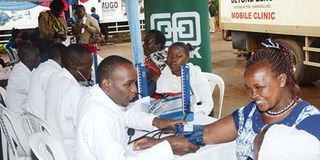Adopting microinsurance will boost UHC

Beth Mugo Cancer Foundation and Co-operative Bank organise a free cancer awareness medical camp at Embu Level Five Hospital on November 1, 2019. Kenya is implementing a universal health coverage plan. PHOTO | GEORGE MUNENE | NATION MEDIA GROUP
What you need to know:
- Technology has been identified as a key success factor, especially in reaching the hitherto uninsured individuals and families.
- A sustainable health microinsurance strategy should also target middle-income earners, especially in the informal sector.
Microinsurance refers to insurance products primarily designed for low-income clients.
The concept has been tested in some countries, including Kenya, and found to be effective in delivering affordable health insurance.
Health microinsurance, as distinguished from commercial microinsurance, is especially vital in helping poor families to cope with financial shocks arising from treatment and management of diseases.
In countries such as Kenya, India, Pakistan and Bangladesh, where it has been tried with varying degrees of success, the model has had a positive impact on the overall health and financial well-being of low-income households.
As Kenya implements a universal health coverage (UHC) plan, it should rapidly expand access to affordable health insurance.
This entails developing sustainable and innovative responses to bring on board multiple players across the healthcare value chain.
Health microinsurance — or micro health insurance — is one such response, particularly in the context of the rising prevalence of communicable diseases (HIV/Aids, malaria, tuberculosis) and non-communicable ones (cancer, diabetes, stroke, hypertension).
HEALTH SIMPLICITY
The growing ‘double-disease’ burden has exposed many families to the risk of financial devastation.
The Ministry of Health estimates that 75 per cent of Kenyan households finance medical treatment out of pocket. This makes health microinsurance all the more imperative.
Besides shielding low-income families from financial risks associated with the double disease burden, its other benefits include improving access to quality healthcare and enabling early treatment and diagnosis of diseases.
Moreover, the money saved - instead of catering for medical expenses - can be used to meet food, education and other pressing needs in homes.
However, successful rollout depends on developing simple products — easy to adopt, capable of wide distribution and deliver a positive customer experience.
In the era of pervasive mobile and digital technology, this should be easy. In fact, such products have been launched in Kenya with a mixture of success and failure.
STRATEGIES
Technology has been identified as a key success factor, especially in reaching the hitherto uninsured individuals and families.
The main challenge lies in developing micro health products that are not only simple to use and deploy but are also backed up by streamlined processes and efficient services.
Such products should also be designed in a foolproof manner to minimise fraud, as well as over-prescription of drugs and medical tests by hospitals, which tend to push up medical insurance premiums.
And we must address the mistrust and misconceptions surrounding insurance. Though relatively more affordable, uptake of health microinsurance can be hampered by poor client experiences, like delayed settlement of claims.
Also, incorporate preventative strategies to promote wellness and healthy lifestyles.
Lastly, a sustainable health microinsurance strategy should also target middle-income earners, especially in the informal sector.
Ms Ndegwa is the chief operations officer, AAR Insurance Kenya Ltd. [email protected]




